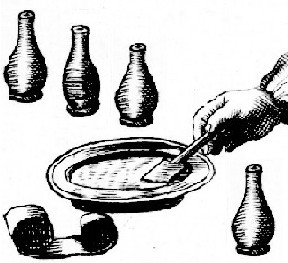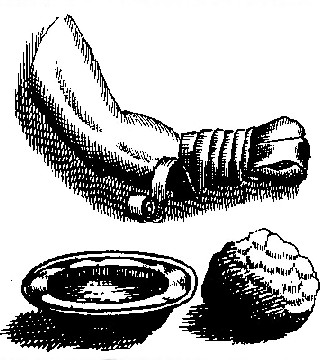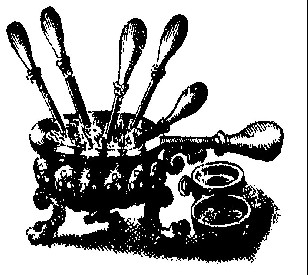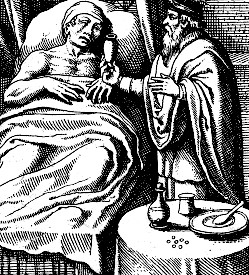
Amputation Page Menu: 1 2 3 4 5 6 7 8 9 10 11 12 Next>>
Amputation During the Golden Age of Piracy, Page 11
Long-Term Healing
"The Patient should be kept in warm Air, in an easy Posture, free from Passions, and with a spare Diet at first, and Phlebotomy, Enema's, Anodyns, cooling Emulsions, and Julaps, administred as they are alternately indicated." (John Atkins, The Navy Surgeon, p. 129)
Post-operative procedures and treatment could last a month or more. Two concerns to the surgeons during this period in history were the topical medicines applied, the patient's diet and other internal remedies.
Long-Term Healing: Topical Medicines

While it was healing, the wound would go through several phases. Immediately following the operation, topical medicines were applied that focused on sealing the wound and preventing fever. These were discussed in detail in the section Stopping Blood Loss: Medicines.
The next course of medicines were those used to cause suppuration which encouraged the wound to form pus and force out the "bad humors" as mentioned on the previous page. Other medicines were applied to cause the wound to incarnate - form tissue inside - and cicatrize - form a layer of skin over the healed wound. Finally, surgeons applied medicines to encourage the scaling of the ends of the bones. Let's look at each of these.
Long-Term Healing Medicines: Suppuratives/Digestives
Once the stump was bandaged, medicines were applied to encourage the wound to suppurate and warm it in an effort to force the bad humors out through the vehicles of pus and sweat. Digestives are medicines that encourage the formation of flesh in a wound - suppuration was thought to be a first step in this process. As Ambroise Paré explained the surgeon should "let the digestive be applied to the rest of the Ulcer until it bee come to suppuration; for then you shall give over your digestive and betake you to detersive [detergent/cleansing] and mudificative [cleansing] medicines".1 Paré then gives us a prescription for a rather complex digestive to be used. Unfortunately, the ingredients are all in abbreviated Latin and look like this:
Rx terebinth. ven. lotæ in aqua vitæ {ounce}vj. mellis ros. colati {ounce}iiij. succi plantag. Apij, centaur. minoris, an. (ounce}ij. bulliant omnia simul usque ad consumptionem succorum: auserantur ab igne, addendo farinaæ fab. & hord. an. {ounce}j. theriac. Gal {ounce}ss. aloes, myrrhæ, aristoloch. an. {ounce}iij. corci {scruple}j. fiat mudificativum2

A selection of apothecary weights
(Be happy it's not more relevant to the text.)
Richard Wiseman also gives us several such interesting concoctions in his amputation account.3 While translating them tends to give your author hours of entertainment as he searches through various Pharmacopoeias in hopes of finding ingredients that seem to match the arcane abbreviations of this period, I have left this particular exercise to the reader. (I have done some of the work here - everything in curly brackets followed by i's and j's are weights that have been converted from the bizarre period apothecary symbols. If you need to create such medicines you will need a set of period apothecary weights once you decipher the ingredients.) For those not interested in wading through gobs of period prescriptions, we'll continue the description in general terms.
John Atkins outlines the medicines to be used during bandaging in his book.4 He recommends a digestive unguent, which he says should "be renewed every twenty-four Hours" on the first dressing. It is "to be applied warm and quick, in a Place least exposed to Air; and when done, the Stump placed on a soft Pillow, with a little Elevation, and kept moderately warm." He also suggests a fomentation "designed to give a Perspiration, and cherish the Heat of the Part, which of Consequence promotes Digestion [pus formation]." Atkins tells us a "good Digestion" takes "a week, more or less".
Following digestion, "the Pain assuredly remits, and the Fever, which was only symptomatical, vanishes." Then the goal of the medicines used changes. "[O]ur great Care being now to prevent a Fungus and an Exfoliation [scaling off of dead portions] of the Bone. To facilitate this, Atkins advises "forbearing any further Use of greasy Applications, for such allowedly do both; they foul the Bone, by increasing Corruption, and render the Flesh soft and spungy. I have seen in an aged Man, the Stump wholly covered with a thick Fungus; so as to oblige us to cut it off with Scissars every Day." Atkins feels the greasy medicines create "too great a Discharge [of pus]", encouraging the formation of this fungus. He also warns against "Medicines too astringing" because stopping the discharge of pus "will occasion Apostemations [swollen abcess], Tumors, and painful Contractions of the Muscles."
1 Ambroise Paré, The Apologie and Treatise of Ambroise Paré, p. 154; 2 Ibid.; 3 Richard Wiseman, Of Wounds, Severall Chirurgicall Treatises, p. 454; 4 Rather than clutter up rest of this section with extensive footnotes, I'll just note that everything remaining is taken from John Atkins, The Navy Surgeon, p. 127
Long-Term Healing Medicines: Incarning and Cicatrizing
Pierre Dionis says "we then continue Dressing it with Mundificatives, Incarnatives and Desiccatives".1 All of these are medicines used to help the wound heal. Mundificatives are medicines which are used to cleanse the wound. Incarnative medicines cause the growth of flesh inside of wound. Dessicatives are medicines that

L'Arcenal d'Chirurgerie by Johannes Scultetus, p 105
dry the wound and stop it from producing fluids. Wounds build tissue from the bottom up; in the case of an amputation, incarnative medicines would be used on the wound under the sutured skin inside of the stump.
John Moyle explains "when you find the Wound sufficiently digested, then leave off the [Digestive medicine] and dress only with Basilicon major, or mixt with Linimentum Arcei [a mild stimulant for incarnation in ulcers] (which is better)... [at] every dressing let the comfortable stupe be applyed out of your warm foment, for that conduceth very much to kindly healing".2 He goes on to recommend, "the Compound Liniment (that is) Liniment. Arcei [Unguentum Elemi or yellow basilicon - a mixture including a tree resin and turpentine], and Ol. Hypericon Compositum [St. John's Wort], and Ol. Cera [Oil of wax]... your Wound would be healed and siccatrized much the sooner.... But we generally at Sea keep to the good old Basilick Medicine; because it is best known, and well approved, and earlier made, and cheaper withal."3

L'Arcenal d'Chirurgerie by Johannes Scultetus, p 105
Cheapness of medicines was important to the sea surgeon, who was given a stipend at the beginning of a voyage that was used to buy the tools and medicines he required for that voyage. The less a surgeon paid for his supplies, the more he could buy of them. (Or the more he could pocket, assuming his piratical side overtook his healing side.)
Moyle refers to healing the wound so it could be "siccatrized much the sooner". Siccatirizing (cicatrizing) is the healing over of an incarnated wound with scar tissue or epidermal skin. It can not take place until the wound has incarned or filled with flesh. For cicatrization, he suggests "Linimentum Arcei in Aq. Stiptica [aqua styptica – sulfates of zinc and copper in rose water]... apply it, and your work will be done".4 Moyle notes that "tis usual to mix the Liniment, & desiccative together, in the skining of a Wound."5 Dionis warns that cicatrization "is not easily done, because being round the Scar must of necessity grow from the circumference to the middle Point or Center."6 This is a common concern voiced by several of the period surgeons discussing the healing of wounds - long wounds heal easier than round ones. Nothing is quite as round as the stump left behind after amputation.
One issue Ambroise Paré warns of during incarnation is the formation of 'proud flesh.' This is an excess of the soft, moist, bumpy flesh that grows beyond the wound when it is healing. Paré says, "All these things being performed, you shall hinder the growth of proud flesh with the cathærticks [cleansing poisonous liquids], such as are burnt vitrioll, the pouder of Mercurie, and other things, amongst which is Alome [Alum] burnt and poudered, which is excellent in these kinds of wounds whether by it selfe or mixed with others. You shall use these and such like, even unto the perfect agglutination [adherence of the wound edges] and cicatrization [healing over with scar tissue] of the wound, and you may of your selfe devise other things, such as these as occasion shall offer it selfe."7
1 Pierre Dionis, A course of chirurgical operations: demonstrated in the royal garden at Paris. 2nd ed., p. 414; 2 John Moyle, The Sea Chirurgeon, p. 59-60; 3,4,5 Ibid., p. 61 6 Dionis, p. 414; 7 Ambroise Paré, The Apologie and Treatise of Ambroise Paré, p. 155
Long-Term Healing Medicines: Scaling
Scaling of the bone or bones at the end of the stump was another part of the amputation healing process. Scaling occurs when the blood flow stops to a part of the bone causing it to die and "scale" off. Ambroise Paré explained that "in dressing these wounds, the Chirurgion must use diligence to procure the falling away of the ends or scalls [scales] of the bones".1

L'Arcenal d'Chirurgerie by Johannes Scultetus, p 50
Curiously, Paré - the surgeon most responsible for stopping the use of cautery irons to arrest bleeding, recommends them instead of medicines for bone scaling. He tells the surgeon to, "have actuall cauteries, that is, hot irons in using of which you must have a speciall care that you touch not the sensible parts with fire; neither must the bones themselves bee forcibly pluckt off, but gently mooved by little and little, so that you shall thinke you and the patient have exceedingly well performed your parts if they fall away at the thirtyeth day after the Amputation."2
John Moyle suggests a gentler path using medicines. He tells the surgeon to place cloth "with Pouder of Myrrh on the end of the bone, for should any Unctious Medicines touch the bone, it would foul it, (it would give way to liquid humours to fall upon it, and putrifie it.) By this kind of dressing the end of the bone will last exfoliate, and the flesh will grow over it, and then you may leave off the Pouder of Myrrh".3 Pierre Dionis agrees that ointments or 'unctious medicines' not be used "but only Pledgets moisten'd in Spirit of Wine, in expectation of their crumbling off, or Exfoliation [of the bone]."4
1 Ambroise Paré, The Apologie and Treatise of Ambroise Paré, p. 155; 2 Ibid.; 3 John Moyle, The Sea Chirurgeon, p. 59; 4 Pierre Dionis, A course of chirurgical operations: demonstrated in the royal garden at Paris. 2nd ed., p. 414
Long-Term Healing: Diet
"[T]o make these local Applications more effectual, that we prescribe a Regularity in the Non-Naturals, and give convenient Internals." (John Atkins, The Navy Surgeon, p. 129)
Just as the pre-operative diet was of concern to period surgeons, so the post-operative diet is addressed by them. Pierre Dionis suggests "a strict diet"1, but doesn't give further details. John Moyle recommends the patient "keep to the Dieta salubriosa, (avoiding all strong drink, and salt and vitious Aliment)".2 John Woodall gives us a more descriptive dietary prescription. "[A]ppoint him a slender diet, namely no flesh: let him have a comfortable Caudle [a syrupy gruel containing spices and wine or ale] for the first, if you see him weak; and afterwards Broths and Pannadons [a gruel made with bread - thanks to Grymm at Pyracy.com for identifying this] and light things, and in small quantity."3

From Administration de Efficaci Medicina Libri Tres
by Marco Aurelio Severino, Title page (1646)
Period surgeons had various reasons for suggesting diets, often associating certain types of foods with formation of certain types of humors. They could also had much to do with keeping the patient's spirits up. Physician Thomas Aubrey explains that "the Meat, or Drink, with which they [bodies] are nourished, [of which] the better, i.e. the more noble part of them are changed into Humours, and so at length into Spirits."4 Aubrey is here referring to Animal Spirits, a concept popular from the middle ages through the 18th century. Paré also mentions them when talking about using ligatures on the arteries, warning that "the animall spirits by the straite [tight or severe] compression [are] hindred from passing in by the Nerves."5
Animal spirits are a concept from the works of 2nd century surgeon Galen of Pergamon. Galen was one of the classical surgical authors whose works were still being taught to surgeons and physicians during the golden age of piracy. Although the medical community was beginning to break away from such classical surgical theory and towards experimental methods, this transformation was slow, taking well over a hundred years. Galenistic methods were still highly regarded by many surgeons during this time.
The concept of animal spirits is a bit intricate, but it bears explanation. According to the Galenistic theory, digested food (or chyle) was transformed in the liver into impure blood which contained pnuema or natural spirits. The blood then went to the heart where impurities in the pneuma were removed and exhaled by the lungs. The purified blood traveled through the arteries to the base of the brain where it was further modified, producing the purest form of pnuema - animal spirits. Animal spirits then circulated around the body guiding movement and thought.6 These animal spirits needed to be constantly renewed in order for the human body to continue living7 which is probably why Paré was concerned with overly tight ligation. The quality of the animal spirits depended on the quality of the blood from which they were distilled8 which came from the food used to produce them. So diet was considered a crucial part of regaining health after such an operation.
1 Pierre Dionis, A course of chirurgical operations: demonstrated in the royal garden at Paris. 2nd ed., p. 414; 2 John Moyle, The Sea Chirurgeon, p. 61-2; 3 John Woodall, the surgions mate, p. 175; 4 Thomas Aubrey, The Sea-Surgeon or the Guinea Man’s Vadé Mecum, p. 3; 5 Ambroise Paré, The Apologie and Treatise of Ambroise Paré, p. 149; 6 David Blitz, "Galen's Physilogical System", gathered from Central Connecticut State University, 5/2/2012; 7 Ibid.; 8 John Sutton, "Animal Spirits: The Mind in History", gathered from the All in the Mind website, ABC Radio Australia, 5/1/2012

